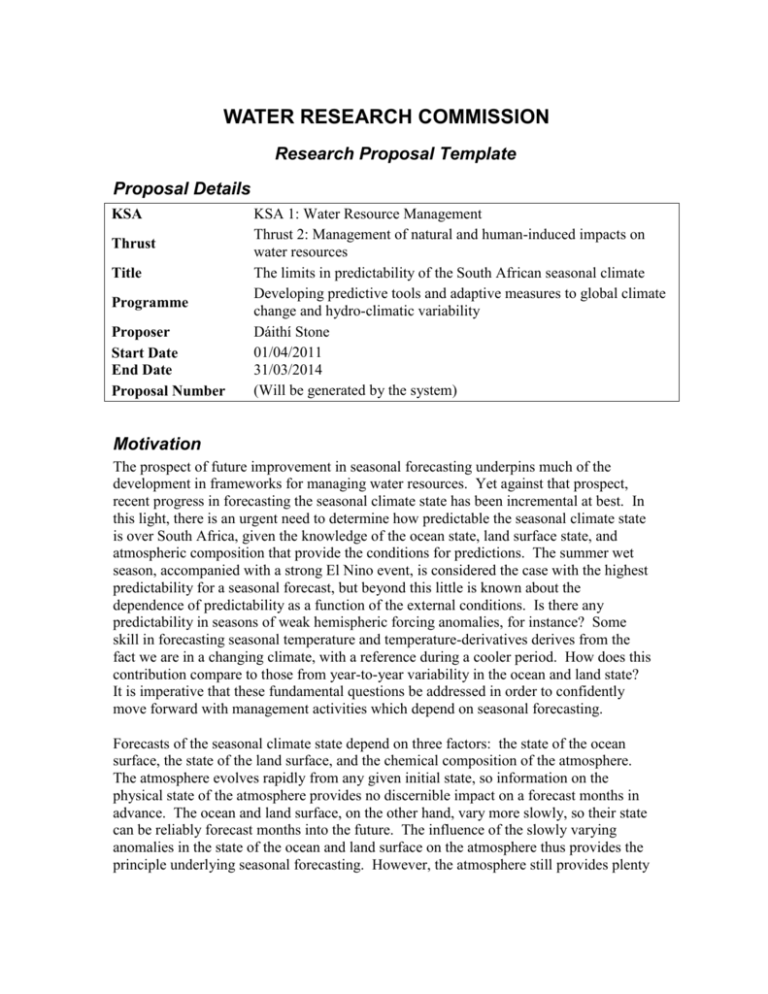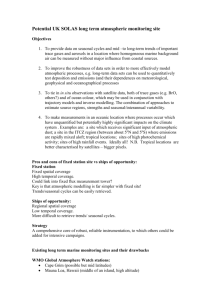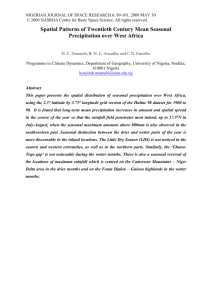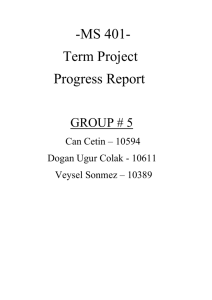doc - CSAG - University of Cape Town
advertisement

WATER RESEARCH COMMISSION Research Proposal Template Proposal Details KSA Thrust Title Programme Proposer Start Date End Date Proposal Number KSA 1: Water Resource Management Thrust 2: Management of natural and human-induced impacts on water resources The limits in predictability of the South African seasonal climate Developing predictive tools and adaptive measures to global climate change and hydro-climatic variability Dáithí Stone 01/04/2011 31/03/2014 (Will be generated by the system) Motivation The prospect of future improvement in seasonal forecasting underpins much of the development in frameworks for managing water resources. Yet against that prospect, recent progress in forecasting the seasonal climate state has been incremental at best. In this light, there is an urgent need to determine how predictable the seasonal climate state is over South Africa, given the knowledge of the ocean state, land surface state, and atmospheric composition that provide the conditions for predictions. The summer wet season, accompanied with a strong El Nino event, is considered the case with the highest predictability for a seasonal forecast, but beyond this little is known about the dependence of predictability as a function of the external conditions. Is there any predictability in seasons of weak hemispheric forcing anomalies, for instance? Some skill in forecasting seasonal temperature and temperature-derivatives derives from the fact we are in a changing climate, with a reference during a cooler period. How does this contribution compare to those from year-to-year variability in the ocean and land state? It is imperative that these fundamental questions be addressed in order to confidently move forward with management activities which depend on seasonal forecasting. Forecasts of the seasonal climate state depend on three factors: the state of the ocean surface, the state of the land surface, and the chemical composition of the atmosphere. The atmosphere evolves rapidly from any given initial state, so information on the physical state of the atmosphere provides no discernible impact on a forecast months in advance. The ocean and land surface, on the other hand, vary more slowly, so their state can be reliably forecast months into the future. The influence of the slowly varying anomalies in the state of the ocean and land surface on the atmosphere thus provides the principle underlying seasonal forecasting. However, the atmosphere still provides plenty of "noise" on top of any predictable signal. Understanding of the fundamental limit this imposes on the predictability of seasonal forecasts for South Africa remains weak. Beyond this, the atmosphere is a highly nonlinear dynamical system. This complicates our understanding of the predictability of the seasonal forecast -- the degree to which an accurate prediction is possible. The predictability is undoubtedly itself also a function of the ocean and land surface states. For example, in conditions with weak anomalous surface forcing, there may be little scope for an accurate prediction, whereas in conditions with strong forcing, such as an El Nino event, the atmospheric state may be highly constrained. There remains little understanding of how predictability varies as a function of the surface state, other than the existence of a relatively higher predictability in summer wet seasons during El Nino events in the tropical Pacific. Thus, at the moment it is unknown whether management strategies should require the flexibility to focus on strong preparatory measures during some seasons and forecast conditions but more open, responsive measures during other cases. Seasonal forecasts are frequently expressed as anomalies from a historical reference, both due to climate model limitations and user relevance. In a changing climate, however, that historical reference may be biased and thus may be providing "artifical" (yet relevant and useful) skill. In particular, forecasts of warmer-than-normal seasons are more frequent these days than forecasts for cooler-than-normal seasons, because "normal" is defined with relevance to a cooler past climate. It is currently unknown how much changes in atmospheric composition, such as increasing greenhouse gas concentrations, are contributing to the predictability of seasonal forecasts for South Africa. This contribution is highly relevant, though, in understanding the potential usefulness of seasonal forecasting. First, if predictability is a strong function of atmospheric composition, then the future accuracy and relevance of seasonal forecasting will depend explicitly on international activities to reduce emissions of greenhouse gas and various aerosol precursors. Second, it provides a connection between forecasting and longer term climate change. This is highly relevant in Africa, where adaptation in the near-future is the priority climate change issue. In particular, the ability to tap international funding mechanisms for climate change adaptation activities will likely depend in part on there being a demonstrable impact on current climate risk. Current climate risk is generally estimated through seasonal forecasting, but as yet there has been little study of the climate change contribution through the seasonal forecasting framework. Knowledge Contributions The current development of water resource management frameworks assumes that further advances will be made in the accuracy of seasonal forecasts. This project will test that assumption and provide an estimate of how far such advances may be expected to reach. Furthermore, it will provide an indication of how the accuracy may vary according to forecast case. Climate change contributes to the accuracy of seasonal forecasts. This project will quantify that contribution for South African climate, indicating how much forecast accuracy depends on future climate change mitigation activities. Historical emissions have also lead to a different level of weather risk than might otherwise have occurred. This project will estimate that contribution, providing a resource for determining the allocating of funding for climate change adaptation. Impacts: Society Society assumes a certain level of weather risk, implicitly or explicitly through insurance, engineering, and planning. In a changing climate, however, the adaptation to weather risk may be for a past climate that differs substantially from the current climate. This project will estimate how biased such risk estimates may be. Furthermore, such changes in weather risk may have been caused by anthropogenic activities. This project will estimate that contribution, providing a resource for allocating funding for climate change adaptation. Economy A number of economic activities, ranging from water management to insurance, use seasonal forecast products in their operational and strategic decision-making. This project will provide an estimate of how much more scope for improvement remains in the production of seasonal forecasts, and thus how much more such economic activities can utilise the seasonal forecast resource. Furthermore, with considerable funding resources becoming available for climate change adaptation activities, the information on weather risk attribution provided by this project could affect the allocation of this funding. Health There has been increased interest in the possibility of forecasts of the seasonal forecast state providing useful information for forecasting outbreaks of water-dependent diseases. This project will provide an indication of how much more the climate side can contribute to this epidemiological predictability. Environment Some environmental management uses seasonal forecast products, and thus may find similar uses of the results of this project as described in Economy and Health. Aims No 1 2 3 4 5 Aim To determine the limits of the predictability of the South African seasonal climate state and how these limits depend on the season and on the ocean and land surface forcing. To determine the robustness of the estimated predictability properties to choice of atmospheric model. To estimate the contribution of anthropogenic emissions to forecast predictability. To estimate the contribution of anthropogenic emissions to climate risk. To characterise the relevance of the limits of predictability in the operational forecast setting. 6 Methodology This proposal aims to address the aims using a "perfect model" hindcast framework. In particular, it will take advantage of the existing southern African regional modelling setup on the climateprediction.net facility. This unique setup will allow the production of an unprecedented thousands of simulations of a high resolution atmospheric model for the conditions observed each year over the last half century. The climateprediction.net project (http://www.climateprediction.net) is the world's largest climate modelling facility. It uses the BOINC facility to run climate models on volunteered idle personal computers (PCs) around the world. The Climate Systems Analysis Group (CSAG) at the University of Cape Town have been collaborating with the climateprediction.net team and the U.K. Met Office on a project to model southern African climate (http://climateprediction.net/content/regional-model). In particular, it uses a 50km resolution regional atmospheric model embedded in a global model. The system is currently at the beta-test stage, with a public launch envisaged for September 2010. The development of this system was funded by Microsoft Research. This proposal seeks funding to conduct and analyse experiments with this regional modelling setup. All analysis will be performed by CSAG. Distributed computing allows the generation of vastly larger ensembles of simulations than possible on solitary supercomputing systems. A single simulation job is sent out to each volunteered PC. While the use of PCs mean that the simulations each take longer than with an in-house cluster, with thousands of PCs it is possible to generage unprecedentedly large ensembles. In seven years, the climateprediction.net project has run various climate models for a total of over 60 million years of simulation. The current regional model setup takes a few weeks to conduct a year of simulation on a typical PC. Thus, thousands of years worth of simulation should be available for this project. The University of Oxford will support this project through operation of the climateprediction.net facility, while Penn State University will host the data upload server. With such a large number of simulations per year, it will be possible to directly estimate the distribution of possible climate states for each season, including the frequencies of unusual events which are usually estimated through statistical extrapolation. The variation of these distributions from year to year will give an indication of how predictable the seasonal climate state is. Furthermore, comparison of these distributions across certain ocean temperature forcing features, such as El Nino events, will provide a measure of the degree to which the predictability is a function of the ocean state. First, simulations of the basic version of the atmospheric model will be examined, i.e. simulations for each year will only vary in their initial atmospheric state. A number of seasonal average and intra-seasonal quantities will be examined, including for instance the average seasonal temperatures to the onset date of the wet season. The analysis will compare the spread across simulations according to ocean surface state. For this analysis the standard version of the atmospheric model will be used. However, other plausible atmospheric model implementations are possible, for instance incorporating different algorithms to describe the formation at clouds at spatial scales smaller than are resolved by the model. The simulations conducted for the above analysis will be repeated, but in this case spanning a number of possible alternative implementations of the model. The focus will be on alternative representations of convective cloud processes and land surface processes. Following that, an analysis of trends in forecast quantities in the above simulations will be conducted, including how these trends relate to the year-to-year variability, the external conditions, and the overall predictability. Furthermore, another set of simulations will be conducted, but in which atmospheric concentrations are maintained at pre-industrial levels, and in which ocean surface temperatures are cooled by an proportional amount. Thus, it will be possible to say how much current climatic conditions differ from those that would have been had human activities never affected the atmosphere. CSAG also runs its own seasonal forecasting product (http://www.gfcsa.net/csag.html) using atmospheric model versions related to those used in the climateprediction.net project. An "attribution forecast" is also being developed, with an expected public launch in September 2010. This attribution forecast compares the seasonal forecast with an alternative forecast of what the world would have been like had humans never emitted greenhouse gases, thus estimating the degree to which historical emissions are to blame for certain types of weather risk. Because these products are generated operationally inhouse, the number of simulations is considerably smaller than possible with climateprediction.net; however, the in-house setup makes it possible to record more diagnostics from the simulations. It is envisaged that these in-house products will provide further data to supplement the analysis performed on the climateprediction.net output, for example providing a further sample of atmospheric model versions. Most importantly, though, the operational generation of these products will provide a framework for determining the degree to which conclusions reached in the analyses of this project relate to the operational seasonal forecast setting.








